Manage Meetings Assignment
Added on 2021-02-20
37 Pages7693 Words98 Views
1.Name: _________________________

2.Assessment criteria for BSBADM5023.Manage MeetingsIn this document, you will find the foundation of what is required to become competent in this unit. For further information on each element, you can refer to the Assessment Matrix. Included in this document are the elements for the unit, foundation skills, assessment requirements as well as an assessment tool definition list and the crucial observation and third-party check lists. As well as all the areas covered here, each student must also complete all workbook activities, case studies and major activities, where stated, to become competent within this unit.NOTE – Re-assessment:Students will have amaximum of two (2) reassessments attempts if competency isnot achieved in the first instance.The final grade of ‘C’ for Competent or ‘NC’ for Not Competent is only given at the completion of the unit of competency when all components or parts of the assessment are graded as ‘S’ for Satisfactory. Unsatisfactory results are marked asNS.Elements for Competency DemonstrationElements for Competency Assessment:1.Prepare for meetings2.Conduct meetings3.Follow up meetingsPerformance Evidence:Evidence of the ability to:Apply conventions and procedures for formal and informal meetings including:developing and distributing agendas and papersidentifying and inviting meeting participantsorganising and confirming meeting arrangementsrunning the meeting and following upOrganise, take part in and chair a meetingRecord and store meeting documentationFollow organisational policies and procedures
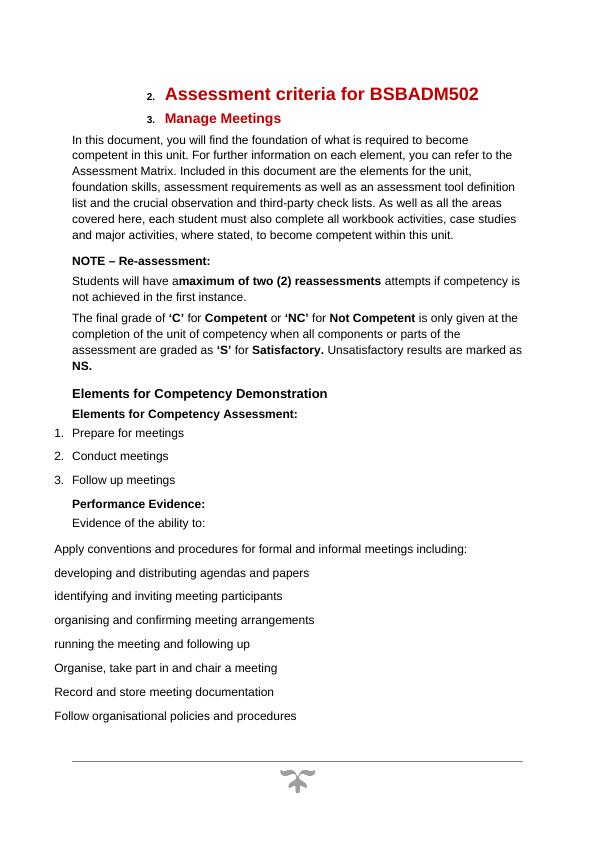
P a g e | 3Foundation Skills:ReadingIdentifies and interprets information from complex texts including legislation, organisational policies and proceduresCompares final output with original notes to check for accuracyWritingAddresses the context, purpose and audience when generating a range of textsPrepares complex texts from notes using appropriate structure, and accurate spelling, grammar and punctuationRecords notes of meeting proceedings according to organisational requirementsEdits and corrects own work to ensure accuracyOral CommunicationParticipates in verbal exchanges using appropriate style, tone and vocabulary for audience, context and purposeListens for specific information during meetingsAsks questions and listens to responses to clarify understandingNumeracyRecognises and interprets numerical information related to timeframes and budgetsNavigate the world of workRecognises and responds to both explicit and implicit organisational procedures and protocols and legislative/regulatory requirementsInteract with othersSelects the appropriate form, channel and mode of communication for a specific purpose relevant to own roleCooperates with others as part of familiar activities, playing an active role in facilitating group interactionGet the work doneApplies formal processes when planning complex tasks, producing plans with logically sequenced steps, reflecting an awareness of time constraintsRecognises and takes responsibility for addressing predictable problems in familiar work contextsKnowledge Evidence:
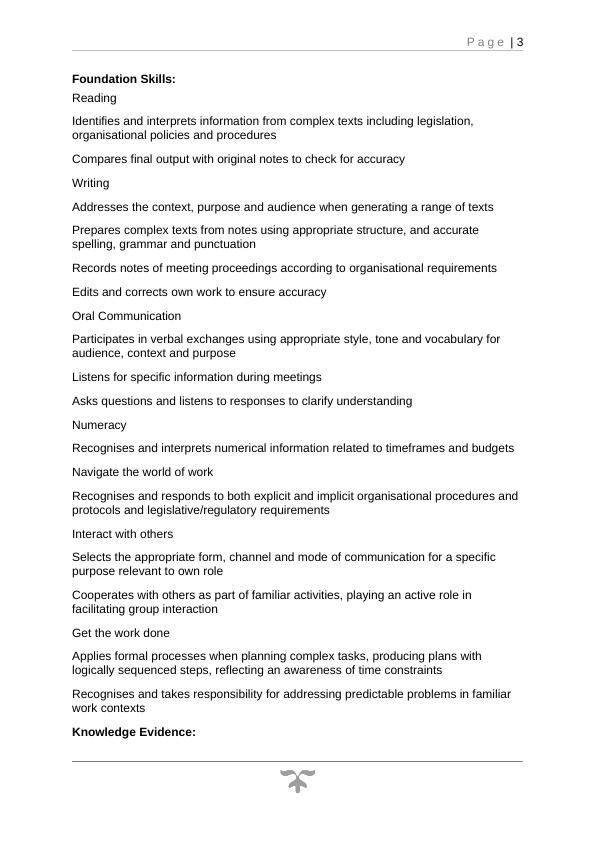
To complete the unit requirements safely and effectively, the individual must:Outline meeting terminology, structures, arrangementsOutline responsibilities of the chairperson and explain group dynamics in relation to managing meetingsDescribe options for meetings including face-to-face, teleconferencing, web-conferencing and using webcamsIdentify the relevant organisational procedures and policies regarding meetings, chairing and minutes including identifying organisational formats for minutes and agendasAssessment Conditions:Assessment must be conducted in a safe environment where evidence gathered demonstrates consistent performance of typical activities experienced in the general administration field of work and include access to:Reference material regarding meeting venues and technology, catering and transport suppliersOrganisational policies and procedures for managing meetingsOffice supplies and equipmentComputers and relevant softwareCase studies and, where possible, real situationsAssessors must satisfy NVR/AQTF assessor requirements.Links:
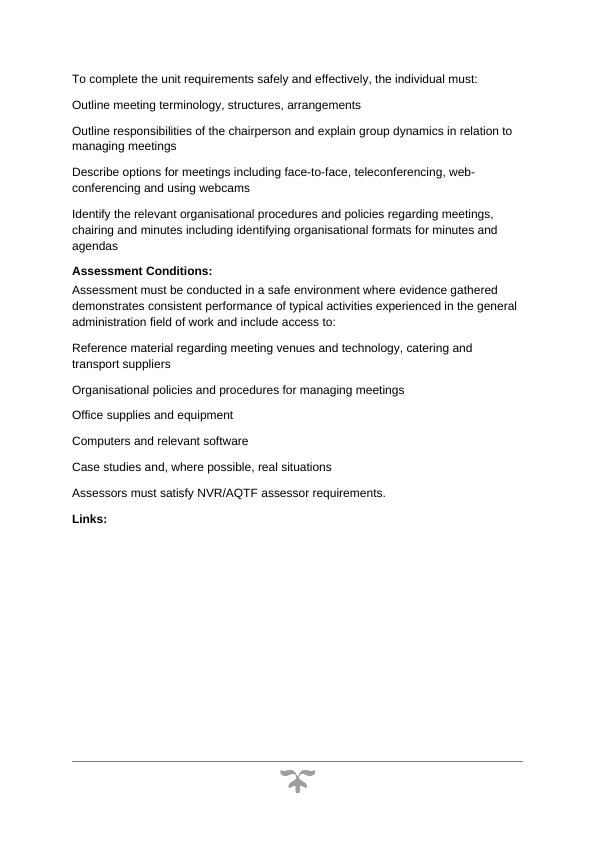
P a g e | 5Companion volumes available from the IBSA website: http://www.ibsa.org.au/companion_volumes - http://www.ibsa.org.au/companion_volumesAny observations and practical assessments must be recorded in the observation checklist. All practical tasks should be demonstrated during the length of the course. As the instructor, you must maintain a record demonstrating the date of the practical activities and any comments relevant to the performance of each student. Where a student is not able to demonstrate competence in a practical observation activity, further questioning should be put in its place.As the instructor, you could be assessing the student’s literacy, numeracy and language skills, as well as the content and context of his/her answers.In some cases, you will have to adjust and amend the assessment tools, using different and varied methods (such as oral assessment), to allow students to be assessed according to their needs and abilities.
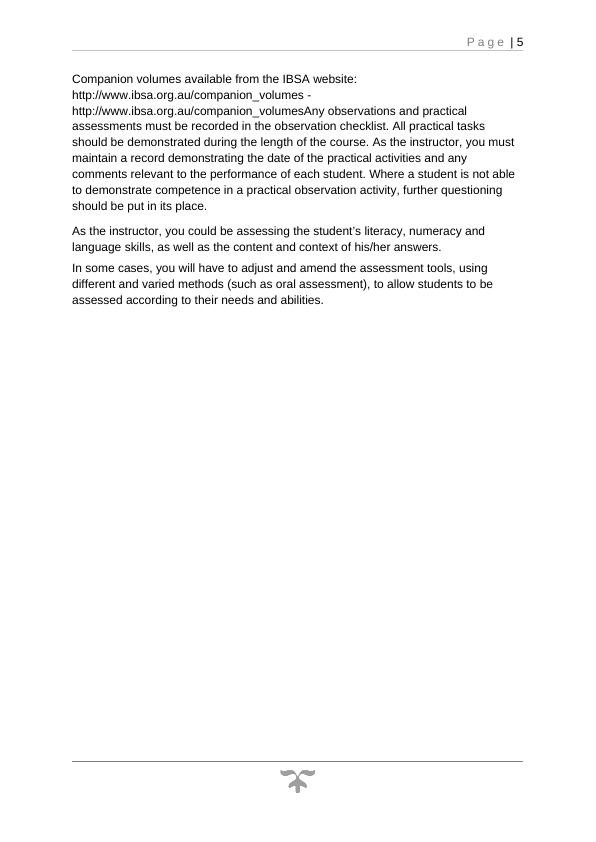
Assessment Tool DefinitionsAssessment ToolHow is it used? What is it?Learner Workbook Activities(Entire completion is required)Each student should be given a Learner Workbook which will hold several activities, both formative and summative, that all need to be completed in conjunction with the appropriate sessions. The PowerPoint, Learner Guide and instructor should provide further information to help with the activities.Observation/Demonstration(To be completed for each numbered point as stated on the checklist)An observation should be completed for each of the students by the instructor. If the tasks aren’t everyday actions, a simulated environment is acceptable, or a demonstration can be set up. An observation checklist can be found at the end of this document.Major Activity(Entire completion is required)A Major Activity is a summative assessment and can be found in the Learner Workbook, after all the activities are completed. This is an extended piece ofsummative assessment which should take anywhere between 1-2 hours and every student should complete this work. It is a requirement for each unit to check knowledge and understanding.Skills and Knowledge Activity(Entire completion is required)A Skills and Knowledge Activity is a summative assessment and is found before the Major Activity in the Learner Workbook. This should take between 1-2hours and every student should complete this work. Itis a requirement for each unit to check knowledge and understanding of the foundation skills and knowledge evidence.Third Party (To be completed for each numbered point as stated on the checklist)A Third-Party checklist is very similar to an Observation Checklist in its format, but it can be completed by someone who works with the learner and has witnessed them completing tasks which coincide with the elements of the unit. The checklist can be found at the end of this document.Case Study(Entire completion is required)Not all units will have Case Studies but those that do will be clearly stated within the PowerPoint and the Learner Workbook. It will appear as any other activity, but it will be named ‘Case Study’ and will provide an example of a possible real-life situation forthe learner to read, interpret and then answer questions on.Learner Guide(To be used as an informational guide)The Learner Guide links with the Learner Workbook as it provides the information given during sessions and more. It can help students to further their knowledge and to also complete the activities.Evidence Document(Not a necessity for completion of unit but can be used as an aid or to collect further evidence)The Evidence Document lists all the Elements and Performance Criteria with an area for written reports etc, to add evidence to the student’s portfolio. It can be used for any of the performance criteria, especially those which may not have been covered by any other assessment tool. The student can circle several the criteria that they may feel they need further evidence of or it can be used as a guide for completing further Observations and Third-Party reports.
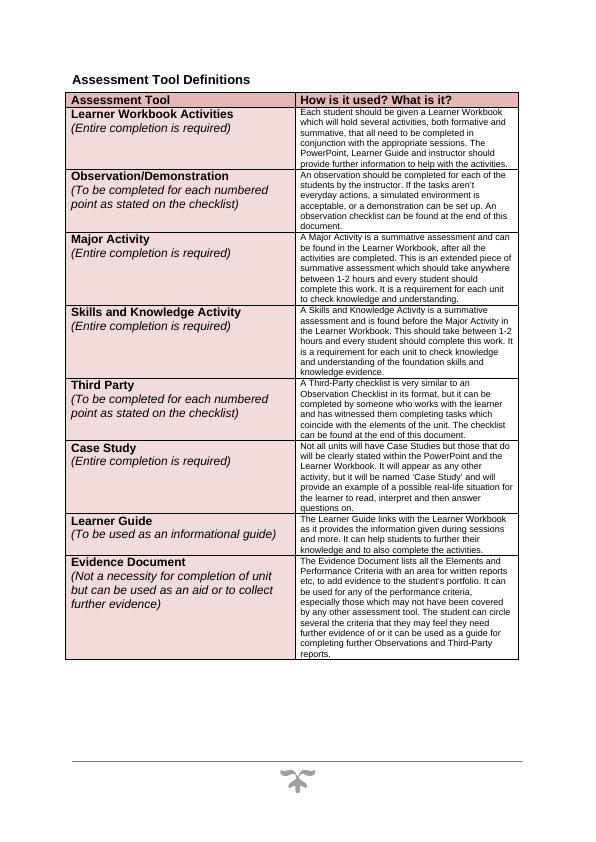
P a g e | 7Observation/DemonstrationThroughout this unit, the learner will be expected to show their competency of the elements through observations or demonstrations. The observations and demonstrations will be completed as well as the formative and summative assessments found in the Learner Workbook. An explanation of demonstrations and observations:Demonstration is off-the-jobA demonstration will require:Performing a skill or task that is asked of youUndertaking simulation exerciseObservation is on-the-jobThe observation will usually require:Performing a work-based skill or task Interaction with colleagues and/or customersThe observation/demonstration will take place either in the workplace or the training environment, depending on the task to be undertaken and whether it is an observation or demonstration. Each task must be observed. You will need to ensure you provide the learner with the correct equipment and/or materials to complete the task. You will also need to inform the learner of the time they have to complete the task; this will once again vary, depending on the task.Learner should be able to demonstrate they can:Prepare for meetingsConduct meetingsFollow up meetingsLearners should also demonstrate the following skills:ReadingWritingOral CommunicationNumeracyNavigate the world of workInteract with others
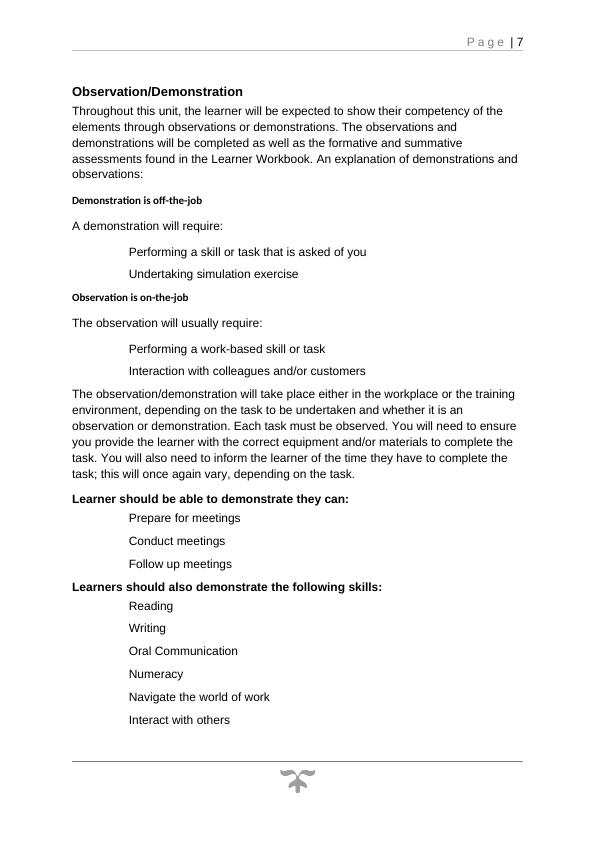
Get the work doneObservation/Demonstration ChecklistUnit of Competence(Code and Title)BSBADM502 Manage MeetingsDemonstration TasksMaterials and EquipmentTasks to be observed, demonstrated or simulated if appropriate YesNoComment1.Prepare for meetings:Did the learner demonstrate that they could develop agenda in line with stated meeting purpose?2.Prepare for meetings:Did the learner demonstrate that they could ensure style and structure of meeting are appropriate to its purpose?3.Prepare for meetings:Did the learner demonstrate that they could identify meeting participants and notify them in accordance with organizational procedures?4.Prepare for meetings:Did the learner demonstrate that they could confirm meeting arrangements in accordance with requirements of meeting?5.Prepare for meetings:Did the learner demonstrate that they could dispatch meeting papers to participants within designated timelines?6.Conduct meetings:Did the learner demonstrate that they could chair meetings in accordance with organizational requirements, agreed conventions for type of meeting and legal and ethical requirements?
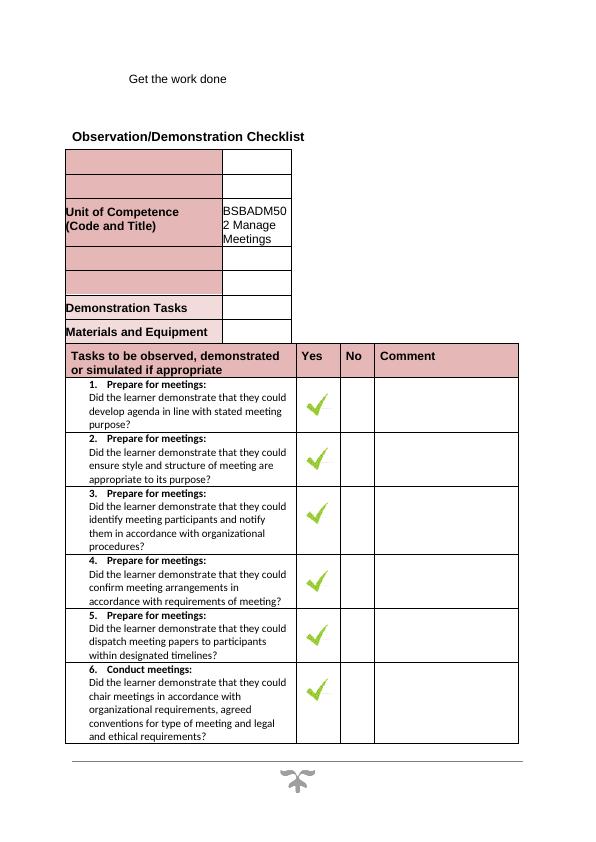
End of preview
Want to access all the pages? Upload your documents or become a member.
Related Documents
BSBHRM501 Manage Human Resource Servicelg...
|74
|13182
|20
BSBHRM501 | Manage Human Resource Serviceslg...
|63
|8946
|10
Manage Human Resource Serviceslg...
|65
|8224
|25
BSBADV507 Develop a Media Plan Learner Workbooklg...
|77
|12712
|231
Assessment Criteria for BSBADV507: Develop a Media Planlg...
|61
|11295
|331
BSBWRK510 Manage Employ Relationslg...
|53
|10088
|30
